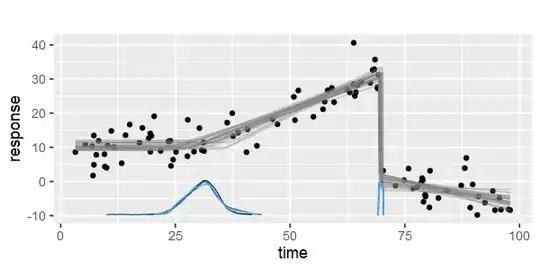I made the R package mcp exactly because there is a lack of packages quantifying the uncertainty (e.g., SE) about the inferred change point locations. Change point problems are conceptually simple in a Bayesian framework, and computationally accessible using variants of Gibbs sampling (read more in this preprint).
mcp includes a dataset with three linear segments:
> head(ex_demo)
time response
1 68.35820 32.842651
2 87.29038 -1.160003
3 69.01173 27.564248
4 11.59361 10.062971
5 19.50091 14.056859
6 46.12009 18.292640
Let's fit a piecewise linear regression with three segments. In mcp you do this as a list one formula per segment:
library(mcp)
# Define the model
model = list(
response ~ 1, # plateau
~ 0 + time, # joined slope
~ 1 + time # disjoined slope
)
# Fit it.
fit = mcp(model, data = ex_demo)
Let's visualize it first:
plot(fit)
The blue curves on the x-axis are the posteriors of the change points. You can see them more directly using plot_pars(fit). Note that they rarely conform to any "clean" known density like the normal distribution.
See summaries using summary(fit). mcp includes functions to test parameter values, model comparison, etc. Read more on the mcp website.

